Physical Address
304 North Cardinal St.
Dorchester Center, MA 02124
Laser and Radiofrequency Treatment of Thyroid Nodules and Parathyroid Adenoma.
RFA of a Thyroid Nodule Using the Trans-isthmic Approach and the Moving Shot Technique.
RFA of a Recurrent Tumor in the Subcutaneous Location with Hydrodissection and the Moving Shot Technique.
Historically, surgery, radioiodine therapy, and levothyroxine medication have been the main treatment options for benign thyroid nodules; however, each of these has particular drawbacks. Surgery results in a scar, requires general anesthesia, and places patients at risk for hypothyroidism, bleeding, and voice change. Radioiodine therapy can pose logistical difficulties for patients and results in the need for lifelong thyroid hormone supplementation. Image-guided ablation techniques, such as ethanol ablation (EA), laser ablation (LA), radiofrequency ablation (RFA), microwave ablation (MWA), and high intensity focused ultrasound ablation (HIFU), have been developed to treat benign thyroid nodules and recurrent thyroid cancers. As clinical applications of EA and RFA increase, RFA guidelines have been published by Korean and Italian groups. This chapter reviews the physics of ablation, ablative techniques, clinical applications, society guidelines, and the results of thyroid RFA and LA studies, with a brief review of the other modalities.
Several factors determine the efficacy of RFA. The first consideration is the temperature around the electrode tip. Irreversible cellular damage occurs when temperatures are increased to 46° C. Near-immediate tissue coagulation is induced between 60° C and 100° C, and temperatures > 100° C result in tissue vaporization and carbonization. Vaporization and carbonization retard optimal ablation. When the tissue around the probe becomes desiccated or charred, it acts as an insulating sleeve around the probe; this limits the transmission of further electrical or thermal energy. When tissue vaporization occurs, a large amount of gas, primarily nitrogen, is released from the cells. The gas that is formed around the electrode acts as an insulator, preventing the production and spread of heat. By maintaining a temperature between 50° C and 100° C, these negative effects can be prevented. The second consideration is the heterogeneity of the target tissue. Fibrosis and calcification can alter the electrical and thermal conductivity of the tissue adjacent to the RF probe; this decreases the predictability of the ablation zone size and shape.
The third consideration is blood flow within or around the tumor. Hypervascularity results in perfusion-mediated tissue cooling due to a heat-sink effect and reduces the extent of thermal ablation. This effect can be used to protect adjacent critical structures from thermal injury by artificially injecting fluid around the ablation target; this process is called hydrodissection .
As evidence supporting thyroid RFA increased, the Korean Society of Thyroid Radiology (KSThR) introduced its first guidelines in 2012 with subsequent revisions in 2018. According to the newly revised KSThR guidelines published in 2018, the inclusion criteria for treating benign thyroid nodules are as follows:
Patients with benign thyroid nodules producing symptoms or of cosmetic concern
Autonomous functioning thyroid nodules (AFTN), either toxic or pretoxic
Thyroid nodules should be confirmed as benign with at least two ultrasound (US)-guided fine-needle aspirations (FNA) or core needle biopsies (CNB) before RFA.
A single benign diagnosis on FNA or CNB is sufficient when the nodule has US features highly specific for benignity or for AFTN. In addition, caution should be taken in the use of RFA in pregnant women, patients with serious heart problems, and those with preexisting contralateral vocal cord palsy.
The exclusion criteria are as follows:
Follicular neoplasm or malignancy on FNA or CNB
A nodule with US criteria suggesting malignancy, despite FNA or CNB results
Cystic and predominantly cystic thyroid nodules, in which EA has been suggested as a first-line treatment.
Surgery is currently the standard treatment for primary thyroid cancer. Based on the current literature, an indication of RFA for primary thyroid cancers is not clearly established. However, in patients with primary thyroid cancer who refuse surgery or are unsuitable for surgery, thermal ablation can be considered as an alternative to surgery. RFA can also be performed for recurrent thyroid cancers in the thyroidectomy bed and in cervical lymph nodes in patients at high surgical risk or who refuse surgery.
Table 16.1 shows the preprocedural checklist before RFA. Symptomatic and cosmetic scores should be evaluated before and after RFA for comparison. Examination by US is important to characterize nodules or recurrent cancers and to evaluate the peritumoral or perithyroidal anatomy. Additionally, the size, echogenicity, proportion of solid component, and internal vascularity of each nodule or tumor should be carefully evaluated. Caution should be taken, especially for thyroid nodules with malignant US features, even in the setting of benign results by FNA or CNB. Three orthogonal diameters, including the largest diameter, should be measured by US, and nodule or tumor volume can be calculated using the equation, [V = π × a × b × c/6], where V is the volume, a is the maximum diameter, and b and c are the other two perpendicular diameters.
| Benign Thyroid Nodule | Recurrent Thyroid Cancer |
|---|---|
| Pathologic diagnosis Benign diagnosis at least two US-guided FNA or CNB Benign diagnosis at least one US-guided FNA or CNB in AFTN Benign diagnosis at least 1 US-guided FNA or CNB in thyroid nodules with highly specific benign US features |
Pathologic and/or serologic diagnosis Cancer recurrence at US-guided FNA or CNB Increased washout Tg level in aspirate or Tg immunostain of CNB specimen Increased washout calcitonin level in aspirate or calcitonin immunostaining of CNB specimen in patients with medullary cancer |
| US Features of the nodule and surrounding critical structures |
US Features of the nodule and surrounding critical structures |
| Nodule volume | Tumor volume |
| Symptom score | |
| Cosmetic score | |
| Laboratory tests Complete blood count Blood coagulation battery Thyroid function test Serum TSH Serum T3 Serum fT4 |
Laboratory tests Complete blood count Blood coagulation battery Thyroid function test Serum TSH Serum T3 Serum fT4 |
| CT or MRI * Technetium 99mTc pertechnetate or 123 I thyroid scan † |
CT or MRI * |
Laboratory tests include a complete blood count, a blood coagulation battery (bleeding time, prothrombin time, activated partial thromboplastin time), as well as a thyroid function test (thyroid-stimulating hormone [TSH], triiodothyronine [T3], and free thyroxine [fT4]). In recurrent thyroid cancer, serum TSH, thyroglobulin (Tg), and anti-thyroglobulin (anti-Tg) antibody should be evaluated. Reduced or negative serologic conversion of these tests is a surrogate marker for successful ablation. When serum TSH is elevated, hormone replacement therapy before RFA can be considered. If hyperthyroidism is clinically suggested, a [ 99m Tc] pertechnetate or iodine-123 ( 123 I) thyroid scintigraphy is needed to confirm AFTN. Hypothyroidism arising after chemical or thermal ablation of thyroid nodules has been rarely reported. However, it may be the result of autoimmune thyroiditis associated with preexisting thyroid antibodies rather than a procedure-related side effect. In patients with positive thyroid antibodies, the possibility of hypothyroidism should be discussed beforehand. Nevertheless, a routine check of thyroid antibodies, such as an anti-Tg antibody or antimicrosomal antibody, before RFA of the benign thyroid nodule, is controversial. Recurrent thyroid cancer should be confirmed by US-guided FNA with measurement of washout Tg concentration before RFA. Computed tomography (CT) or magnetic resonance imaging (MRI) examinations may help in evaluating the intrathoracic extent of the benign thyroid nodules or help in locating recurrent tumors that are undetectable on US. CT is also useful for the post-RFA evaluation of a recurrent tumor. Position emission tomography (PET)-CT or PET-MRI is not routinely recommended before ablation. Informed consent should include discussion of the items listed in Box 16.1 .
Ablated thyroid nodules decrease gradually in size over several months to years.
Number of expected treatment sessions.
Possibility of regrowth of the treated nodule and the need for additional treatment.
Patients may experience various degrees of pain during the ablation.
Complications of RFA.
Patients should inform the physician about their history of thyroid surgery, the side effects of any drugs they are taking, and whether they are taking drugs such as antiplatelet drugs, anticoagulants, or thyroid hormones.
Further observation or admission may be required after RFA, depending on the patient’s condition after ablation.
An RF generator system is shown in Figure 16.2 . The RF generator supplies RF power to the tissue through an electrode (see Figure 16.2, A ). A straight, internally cooled electrode is the mainstay of thyroid RFA. A modified straight internally cooled electrode has been designed with a short shaft length (7 cm) and a small diameter (18- or 19-gauge [G]) to allow for ease of use and reduced trauma to the traversed normal thyroid tissue. Probes with different active tip length are available, including 3.8 mm, 5 mm, 7 mm, and 10 mm lengths (see Figure 16.2, B ). Small active tips, such as 3.8 mm or 5 mm (both 19-G), have been used to treat small recurrent thyroid cancers.
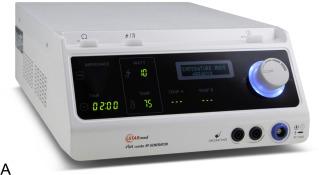
Before each procedure, the patient is placed in the supine position with a mild neck extension ( Figure 16.3 ). Two grounding pads are firmly attached to both thighs to prevent skin burn. An intravenous line should be established in an antecubital vein for intraprocedural medications (e.g., for control of pain or hypertension).
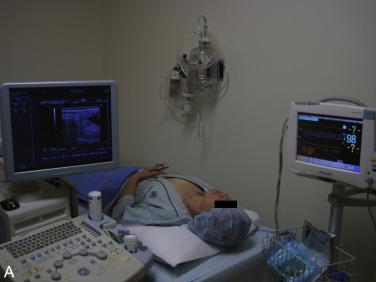
Most operators use local anesthesia during the procedure rather than deep sedation or general anesthesia, which are actions recommended by the 2012 and 2018 KSThR guidelines. Deep sedation or general anesthesia may delay detection of pain as an early warning sign of thermal injury to the perithyroidal critical structures, which can result in serious complications. When providing local anesthesia, injecting sufficient lidocaine at the skin puncture site and around the thyroid capsule is important to alleviate pain during RFA ( Figure 16.4 ).
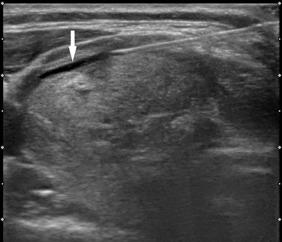
Two key techniques have been proposed and developed by Dr. J.H. Baek: (1) the “transisthmic approach method” and (2) the “moving shot technique” under local anesthesia (see videos). In the transisthmic approach method, an electrode is inserted through the isthmus from medial to lateral and then into the targeted nodule under US guidance. This method has several advantages. First, because the probe is stabilized by the length of the parenchymal track, it prevents a change in the position of the electrode tip caused by the patient swallowing or talking. It also allows for clear US visualization and monitoring of the target nodule, the electrode tip, and their relation to adjacent perithyroidal structures. Injury to the recurrent laryngeal or vagus nerves can be prevented or minimized by continuous US monitoring.
In the moving shot technique, a targeted thyroid nodule is divided into multiple conceptual ablation units, and ablation is performed unit by unit by moving the electrode tip. These conceptual ablation units are smaller in the periphery of the nodule to reduce the risk of thermal injury to the adjacent critical structures, such as the recurrent laryngeal nerve, vagus nerve, esophagus, and trachea ( Figure 16.5 ).
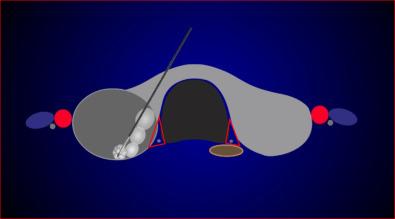
The electrode tip is positioned in the deepest part of a nodule first because the resulting microbubbles will obscure the sonographic window as ablation proceeds. Ablation starts at either 20 W (7 mm active tip) or 50 W (10 mm active tip) of RF power. When a transient echogenic area appears at the targeted ablation unit, the electrode tip is moved to an untreated area proximally. Ablation is performed continuously from deep to superficial distal-to-proximal and deep-to-superficial conceptual units of the nodule by repeated distal-to-proximal movements of the electrode. The extent of the ablated area is determined by increased echogenicity around the electrode. If a transient hyperechoic zone is not formed at the electrode tip within 5 and 10 seconds, RF power is increased in 10 W increments to a maximum of 80 W. If the patient cannot tolerate the pain associated with ablation, the power is reduced or turned off until the pain subsides. The RF ablation is terminated when all conceptual units of the targeted nodule are ablated with transient hyperechoic zones ( Figure 16.6 ). The area close to the danger triangle could remain untreated because of its close approximation to the recurrent laryngeal nerve, trachea, or esophagus (see Figure 16.5 ).
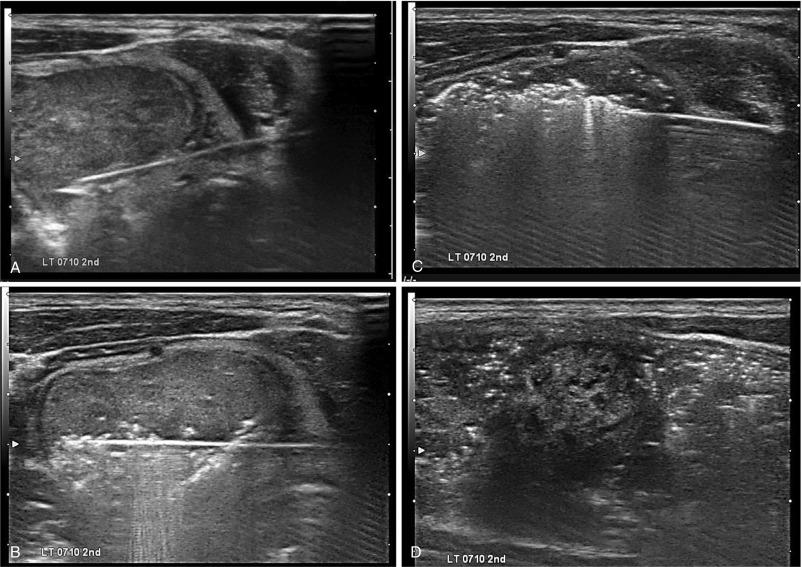
The “hydro-dissection technique” also has been used to achieve a complete ablation of the tumor margin for more peripheral lesions ( Figure 16.7 ). This technique was originally developed for treating the liver to avoid thermal injury to adjacent critical structures. Before the insertion of the electrode, 5% dextrose in water (D 5 W) solution is injected into the tissue plane between the target tumor and the adjacent critical structure to be protected. However, in the neck, the injected fluid may spread rapidly along the longitudinally arranged neck muscle plane. To achieve a sufficient safety margin by hydro-dissection, the fluid should be infused continuously throughout the procedure, with an injection needle remaining in place. A solution of D 5 W is recommended rather than normal saline. Due to its iso-osmolarity (252 mOsmol/L) and nonionic composition, D 5 W does not conduct electricity and provides a thermal barrier to the adjacent structures when it surrounds the target organ.
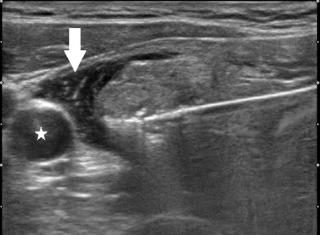
Recently, techniques to prevent marginal regrowth have been suggested, named vascular ablation techniques . To prevent marginal regrowth, the operator should treat marginal vessels around the benign thyroid nodules. These vessels are monitored by color Doppler US, or contrast-enhanced US ( Figure 16.8 ).
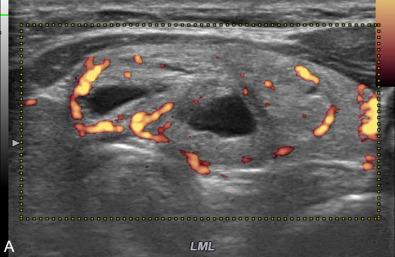
Operators should check for possible complications, such as bleeding or voice changes. The puncture site is manually compressed for 10 to 20 minutes to prevent a potential hemorrhage. After 1 to 2 hours of observation, stable patients are discharged.
Become a Clinical Tree membership for Full access and enjoy Unlimited articles
If you are a member. Log in here